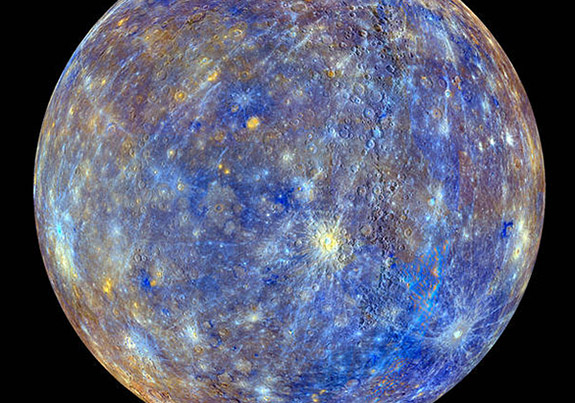March 17th, 2022
Take a look at the surface of Mercury and you'll probably agree that this planet could use a round or two of dermabrasion. With no significant atmosphere to deflect asteroids and comets, the diminutive planet closest to the sun is completely pocked with craters and imperfections.

On the bright side, however, any one of those blemishes could mark an infinite bounty of "shock diamonds," according to Kevin Cannon, a geologist at the Colorado School of Mines, who presented his latest findings at the Lunar and Planetary Science Conference in Houston last week.
Mercury's composition is high carbon (in the form of graphite), so when high-speed foreign objects smash into the surface, the perfect recipe of heat, pressure and carbon results in a diamond byproduct.
“The pressure wave from asteroids or comets striking the surface at tens of kilometers per second could transform that graphite into diamonds,” Cannon noted. “You could have a significant amount of diamonds near the surface.”
According to wired.com, Cannon modeled what was likely to happen to Mercury's crust after being pummeled for billions of year. The geologist theorized that the graphite on the surface of Mercury could be more than 300 feet thick and that the impact pressure from asteroids would have produced enough energy to transform 30% to 60% of that material into "shock diamonds."
If Cannon's math is correct, there could be 16 quadrillion tons of diamonds on the surface of Mercury.
Sadly, it would also be nearly impossible to mine them because Mercury is an inhospitable place. Daytime temps can reach 800 degrees Fahrenheit, while nighttime temps can drop to -290 Fahrenheit.
What's more, the shock diamonds are likely to be very small, widely scattered and of poor quality.
“You’ll end up with a messy mixture of graphite, diamond, and maybe some other phases, as well, so you won’t have nice, beautiful crystals that you could polish up and put on a ring,” Cannon told wired.com.
We will learn much more about Mercury when the BepiColombo mission launched in 2018 finally arrives at that planet in 2025. A joint effort of the European and Japanese space agencies, BepiColombo is equipped with high-resolution cameras that could end the speculation of whether or not diamonds are littered on the surface.
Mercury fun facts:
-- Mercury is just a little bigger than Earth’s moon.
-- It is the closest planet to the sun, but it’s actually not the hottest. Venus is hotter.
-- It takes 59 Earth days for Mercury to make one full rotation.
-- Mercury completes one revolution around the sun in just 88 Earth days.
Credit: Image by NASA/Johns Hopkins University Applied Physics Laboratory/Carnegie Institution of Washington.

On the bright side, however, any one of those blemishes could mark an infinite bounty of "shock diamonds," according to Kevin Cannon, a geologist at the Colorado School of Mines, who presented his latest findings at the Lunar and Planetary Science Conference in Houston last week.
Mercury's composition is high carbon (in the form of graphite), so when high-speed foreign objects smash into the surface, the perfect recipe of heat, pressure and carbon results in a diamond byproduct.
“The pressure wave from asteroids or comets striking the surface at tens of kilometers per second could transform that graphite into diamonds,” Cannon noted. “You could have a significant amount of diamonds near the surface.”
According to wired.com, Cannon modeled what was likely to happen to Mercury's crust after being pummeled for billions of year. The geologist theorized that the graphite on the surface of Mercury could be more than 300 feet thick and that the impact pressure from asteroids would have produced enough energy to transform 30% to 60% of that material into "shock diamonds."
If Cannon's math is correct, there could be 16 quadrillion tons of diamonds on the surface of Mercury.
Sadly, it would also be nearly impossible to mine them because Mercury is an inhospitable place. Daytime temps can reach 800 degrees Fahrenheit, while nighttime temps can drop to -290 Fahrenheit.
What's more, the shock diamonds are likely to be very small, widely scattered and of poor quality.
“You’ll end up with a messy mixture of graphite, diamond, and maybe some other phases, as well, so you won’t have nice, beautiful crystals that you could polish up and put on a ring,” Cannon told wired.com.
We will learn much more about Mercury when the BepiColombo mission launched in 2018 finally arrives at that planet in 2025. A joint effort of the European and Japanese space agencies, BepiColombo is equipped with high-resolution cameras that could end the speculation of whether or not diamonds are littered on the surface.
Mercury fun facts:
-- Mercury is just a little bigger than Earth’s moon.
-- It is the closest planet to the sun, but it’s actually not the hottest. Venus is hotter.
-- It takes 59 Earth days for Mercury to make one full rotation.
-- Mercury completes one revolution around the sun in just 88 Earth days.
Credit: Image by NASA/Johns Hopkins University Applied Physics Laboratory/Carnegie Institution of Washington.


